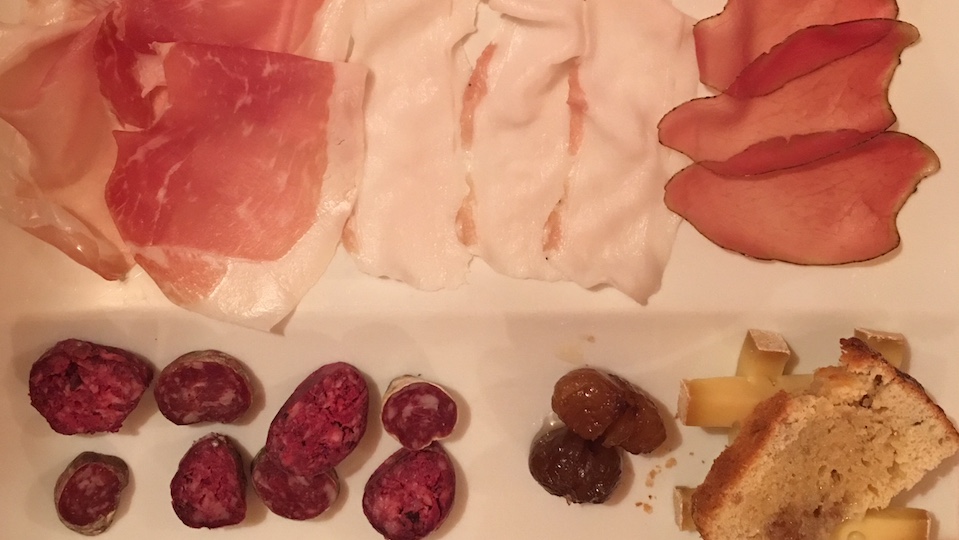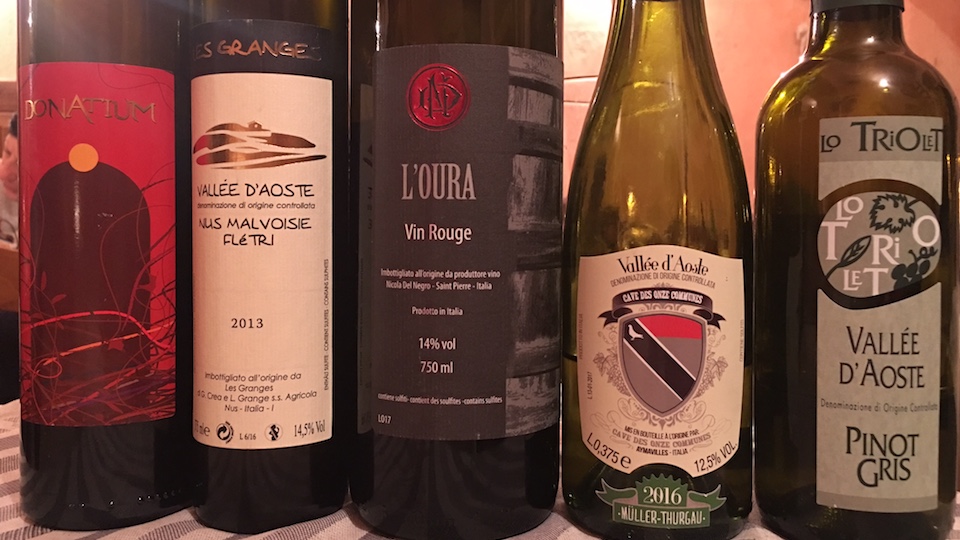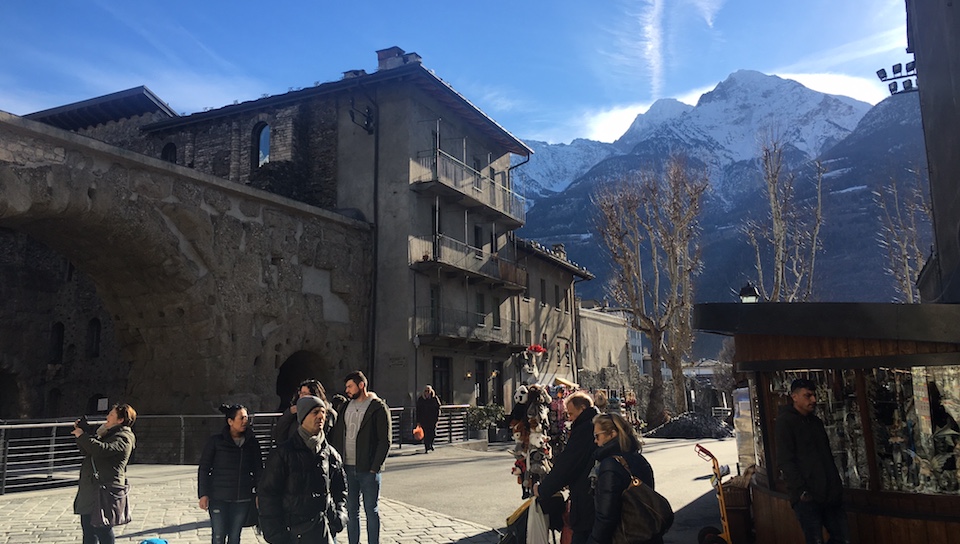Browse using the new Vinous website now. Launch →
Printed by, and for the sole use of . All rights reserved © 2015 Vinous Media
Via Sant'Anselmo, 99
11100 Aosta
Tel. +39 0165 44455
BY IAN D'AGATA | MARCH 16, 2018
The Food:
Mixed Valle d’Aosta salumi (Affettato alla valdostana: mocetta di bovino, lardo di Arnad, jambon de Bosses, saouseusse, boudin, marroni, and Fontina)
Valle d’Aosta fondue with polenta (Fonduta alla valdostana con polenta)
Egg sunny-side up with polenta (Polenta della casa)
Carbonade with boiled potatoes (Carbonade e patate lesse)
The Wines:
|
2016 Cave des Onzes Communes Müller-Thurgau Vallée d’Aoste |
90 |
|
2016 Lo Triolet-Marco Martin Pinot Gris Vallée d’Aoste |
90 |
|
NV Nicola Del Negro L’Oura Vin Rouge |
90 |
|
2013 Les Granges Malvosie Nus Flétri Vallée d’Aoste |
92 |
|
NV Cooperative Donnas Donatium |
91 |
A visit to my favorite Italian
region would feel incomplete without a stop at Da Nando, a traditional osteria of
the kind that is exceedingly rare in Italy these days. Happily, Da Nando, in
business since 1957 when Nando Scarpa and his wife Germana first opened the osteria, continues to hold down the fort
admirably. Son Corrado, his wife Franca and their team continue to deliver well-cooked
food following traditional recipes while also offering a large selection of
wines from Aosta and the rest of Italy. Add a very gentle pricing policy and
warm, caring service and you will soon realize why Da Nando is one of my
favorite restaurants to come in from the cold.

The cozy entrance
And of course, come winter, it is cold in the Valle d’Aosta. I have been visiting this uniquely beautiful alpine region every winter (and usually summers too) every year of the last three decades of my life. Sometimes it seems like climate change has forgotten about this little corner of Italy tucked away into the Alps on the border with France. Clearly, that’s not true, as farmers and producers will tell you that over the last twenty years harvest has been moved up by as much as a month. However, on this night out, the gods of wind and cold weather were happily at work. I remember regretting not wearing a second sweater beneath my jacket on my walk to the restaurant. But winter cold and the brisk and very clean mountain air are an intrinsic part of the Valle d’Aosta’s many charms and beauty, just as its food and wines are.
At Osteria Da Nando you cannot go wrong no matter what you choose to eat. The salumi starter I had was copious and full of high quality meats. The thinly-sliced mocetta, with its delicately spicy yet very flavorful and complex flavors, was especially memorable. Nando’s boudin (a sausage typically made by using pig’s blood in the mix, a traditional ingredient that in our more finicky times is being increasingly dropped) was also noteworthy, as was the local sausage (saouseusse).

Mixed Valle d’Aosta salumi
Fontina is a strongly perfumed cow’s milk cheese that can be eaten either fresh or slightly aged, and that reaches absolute nirvana-like levels of taste ecstasy when turned into a fonduta (fondue), a very common dish in this French part of Italy. Each household has its secret recipe for fonduta alla valdostana, but it almost always involves letting the fontina rest for six hours covered in milk, a process that allows the fonduta to taste smoother and mellower. Honestly, if I weren’t so worried for my poor coronaries, I would have no problems eating two dishes of fonduta every day, two or three times a week, it really is that addictive. The carbonade, a classic stew made with salted dry beef braised in red wine, and the fried egg dish were simple and hearty, if not especially memorable. What is memorable at Da Nando is their whole-meal polenta, one of the best I have had anywhere and one of the reasons I love coming back. It is an especially high-quality cornmeal (made from a blend of ancient corn varieties from the cascina Mamy in Donnas), coarsely ground up and oven-cooked to give an especially grainy and rich mouthfeel, with a depth of flavor that is uncommon in most others you might taste elsewhere (even in the Valle d’Aosta).
Valle d’Aosta fondue with polenta
As always, one of the most fun things about the Valle d’Aosta is trying its unique wines, the best of which are unfortunately made in tiny quantities by small family owned wineries and that are almost impossible to find outside of the region. The 2016 Cave des Onzes Communes Müller-Thurgau Vallée d’Aoste is a simple white wine brimming with early appeal and easy drinking charm. This cooperative is one of Italy’s least known and yet it is, without any doubt whatsoever, also one of the country’s ten best, remarkably adept at making high quality wines at incredibly affordable prices. I can virtually guarantee that anything you’ll choose from their portfolio will prove highly enjoyable. The Müller-Thurgau showcases just how successful this variety is in the region, where growers plant it at high elevations and obtain a minerally, delicately aromatic wine of crisp freshness and lingering perfume. Never a wine of great complexity, it is a joy to drink. Unfortunately it is also very unfashionable, and many producers are uprooting Müller-Thurgau in favor of other more profitable varieties. To be clear, this is a shame, for the region has a long history of excellent wines made from this cultivar, a tradition that would be sad to lose.
Carbonade with boiled potatoes
Lo Triolet-Marco Martin’s Pinot Gris Vallée d’Aoste is one of Italy’s twenty-five best white wines. Owner Marco Martin makes both, the non-oaked version, along with a second bottling aged in barriques, the Pinot Gris Elevée in Barriques. Simply, there is nobody in Italy making two better Pinot Grigio wines than Lo Triolet. That said, the 2016 I tried on this night was less vibrant and concentrated than usual, perhaps because of a less than perfect bottle. Still, the pretty Pinot Grigio-typical apple and pear aromas and flavors, complicated by hints of resin and honey, are pure and fresh.
Young Nicola Del Negro is among Italy’s most talented winemakers and has been doing simply amazing work at the Cave du Mont Blanc de Morgex et La Salle, by far the largest producer of the Valle d’Aosta’s Alta Valle, the high or upper third of the region, right next to France, where two of Italy’s prettiest grape varieties grow: the white Prié and the very rare pale red Roussin de Morgex, which should not be confused with Roussin. Del Negro has recently started making wine from his family’s vines. The NV L’Oura Vin Rouge (a blend of Petit Rouge, Barbera and Dolcetto) is spicy and deep. At 14% alcohol it is hardly the usual dainty Valle d’Aosta red that one drinks most often in the region. I finished dinner off with two lovely sweet wines, a white and a red. The 2013 Les Granges Malvosie Nus Flétri Vallée d’Aoste is a delicate light-bodied sweet wine made with Pinot Grigio (called Malvoisie in the area around the town of Nus where this wine has been made for centuries) and the spicy, Barolo Chinato-like NV Cooperative Donnas Donatium, which brings aromatic, warm, spicy mulled wine-like elements to the evening’s delightful close.
The locals on a Sunday stroll in Aosta




